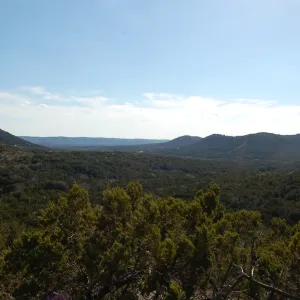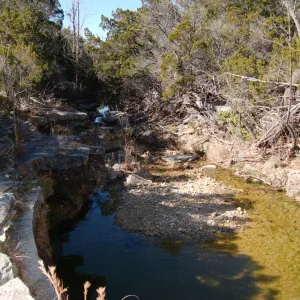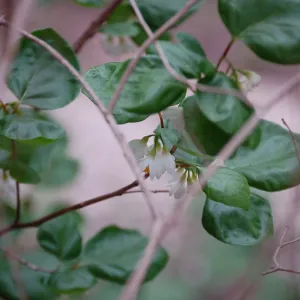by Delmar Cain – Boerne Chapter, Native Plant Society of Texas
Published in the Boerne Star on March 14, 2014
Who doesn’t enjoy a chance to leave the present and travel back in time?
Literature, television series, movies, and river cruises along the Danube, or the Volga or the Yangtze all promise to give us a vision of the past. In fact older people look back so much that I sometimes wonder why their eyes don’t migrate, like those of a flounder, to the back of their heads.
Many of us in the Native Plant Society of Texas have often discussed what the Hill County might have looked like in the past before farming, cattle, sheep and goat ranching and finally an explosive deer population modified the floral landscape. It may not be a perfect picture of the past, but now thanks to a generous gift by Albert and Bessie Kronkosky to the people of Texas through the Texas Parks and Wildlife Department, you can get a view of some spectacular Hill Country property, protected by a high fence and existing without most of those livestock modifications for almost 70 years.

At our last meeting of NPSOT on March 4th, James Rice, Superintendent of the Albert and Bessie Kronkosky State Natural Area (ABKSNA), excited the group with rare and uncommon plants already found, tantalized the group with the prospect of future discoveries and motivated us with the opportunities to help this new natural area secure its place as a true Texas Treasure. Oh, did I mention that, because it is not open to the public in order to get a look at this 3700 acre piece of property, you have to volunteer to help in one of the multitude of projects that are or will be underway?
Albert Kronkosky was a successful San Antonio businessman, who with his wife, Bessie, created a charitable foundation to benefit local organizations in Bexar, Comal, Bandera and Kendall counties. According to Rice around 1947 the Kronkoskys began buying tracts of land, which eventually became the 3K’s Ranch, located about 7 miles west of Boerne on State Highway 46. After the ranch was purchased, it was not “ranched, farmed or hunted”. In time it was high fenced with an 8-foot fence.
Although there was a high fence, apparently there was a high deer population inside the fence at one time. Rice said that a survey of the tree growth indicates that there must have been a deer population “die-off”. Rice and District Leader Rufus Stephens conducted a deer survey, which generally count on the low side, and found about 1 deer per 120 acre. But Rice said that, “even at 1 deer per 60 acres it would be extremely low for the Hill Country”. The result is a very favorable environment for the regeneration of native plants.


What has been found thus far? Besides the high hills, beautiful vistas, and deep canyons with spring-fed streams, there are stands of big-toothed maple, escarpment black cherry, basswood and scattered beautiful Texas madrones. There are also the more rare sycamore-leaf snowbells and canyon mock-orange shrubs, both probably more plentiful when the first European settlers arrived. There are hardwoods and old-stand ashe junipers, which signify nesting habitat for golden-cheeked warblers, which already have been seen on the property and photographed. The possibility of stands of big red sage in some of the remote canyons is not far fetched.
The house that the Kronkoskys occupied for outings has been turned into the regional headquarters for the Texas Parks and Wildlife Department. The history of prior occupancies and uses of the land is an ongoing project. It will include the geological exploration and the investigation of archeological sites. Chert and flint, not mined from the property, has been found along some of the streams.

Although many exciting discoveries have been made, a complete inventory of the property is still in the beginning stages. Before better roads and improvements can be made, those inventories need to be completed to prevent the destruction of undiscovered treasures. Rice said that the main focus for a “state natural area”, is “to preserve and conserve the natural resources.” In order to accomplish that goal the management might limit the types of improvements or even restrict public access.
Rice sees a future that includes the possibility of some limited camping, fields of native wildflowers and milkweed for monarch butterflies, and the regeneration of some of the rare plants like the sycamore-leaf snowbell. There might also be limited public hunts to keep the deer population in check and to eliminate a feral hog population.
The formal opening of the property is still two or three years in the future. The opportunities for volunteers exist now. Projects, which include clearing cedar, checking fences, inventorying plants, birds and butterflies, checking stream occupants and quality, aiding geological and archeological surveys, and staffing the office, are in need of additional volunteer help. Knowledgeable experts will be on hand to guide the projects.
If the scenic views and science projects arouse your interest, you can get started by contacting Tom Riordan, the volunteer coordinator of the ABKSNA, at: tomr63@wildblue.net or Shirley Nedry at: shirleynedry@yahoo.com to find out how to become a TPWD volunteer.
It is not often that one finds the possibility of looking into the past and into the future at the same time. This kind of golden opportunity might motivate one aging retiree to consider keeping one eye on the future and allowing only one eye to migrate to the back of his head.
